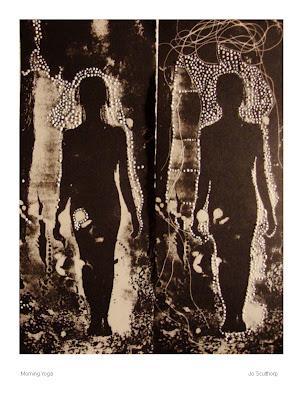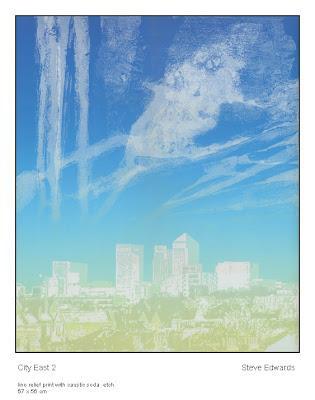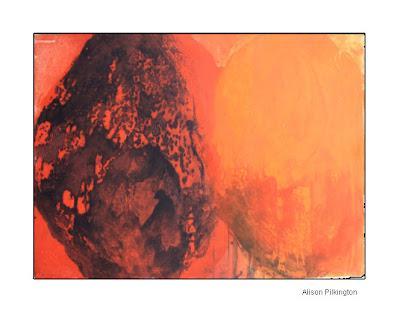 Isn't this gorgeous ...it's by Jo Sculthorp who keeps a blog called the green room - check her out she's an interesting artist. It's lino printed relief and she has used lots of caustic soda.
Isn't this gorgeous ...it's by Jo Sculthorp who keeps a blog called the green room - check her out she's an interesting artist. It's lino printed relief and she has used lots of caustic soda.If you decide to use caustic soda on linoleum - then you need to get all the materials organised and prepared keeping in mind that caustic soda is dangerous stuff.Having said that I don't want to put you off using it. You just need to be sensible.
Items / Implements You will need
SAFETY
Rubber gloves
Maybe some eye goggles in case of splashes
Old newspaper to protect your surfaces
protective apron

artwork by Steve Edwards - its a relief print but I just love what he has done with the caustic soda
ITEMS TO MAKE THE MIX
Caustic Soda Granules
Wallpaper paste flakes
A glass container such as a jam jar or similar to mix the caustic in.
A stick or old wooden spoon to stir the caustic soda mix
A Tea spoon and a Tablespoon for measuring.
Cold water
You will need a lid too, to seal it if there is any leftover. I can not remember how long this stuff keeps but I seem to have the impression that it does actually keep for a long time. We had some at the print workshop I go to (FDPW in Dunfermline) and Bill (our technician) says he made it years ago - it still works !!
To Create Your Mix
Take your glass container and fill it one third full of water.
Into that sprinkle two teaspoons of the dry wallpaper paste flakes.
Mix this together and leave it aside for five minutes, during which time it will thicken up.
Put two teaspoons of caustic soda granules into this mix and then stir it with a wooden spoon or stick. ( don't use metal !!)
The mixture will get warm but don't worry - this is just the caustic soda reacting with the water/paste.
I think its a good idea to get a pencil or biro and write a label to stick on the jar .e.g.,
"2 tablespoons caustic soda and 2 teaspoons wallpaper paste"
also put the date. The mix is ready for you to use on your linoleum.
Of course before you apply the caustic soda mix to your lino plate you will need to consider if you want to first apply some 'resist' onto the plate.

RESISTS
I have to add here that I came across some old book where the person had made a walled off area on a lino plate using putty or modelling clay so I guess you could do that too - I haven't done that myself so don't know about the 'ins and outs' of that approach.
I have also heard that you can use sellotape and parcel packing tape. Actually I did a little test area on a small piece of old lino and used the shiny buff coloured packing tape and made a hole in the middle of it. I put some caustic mix on it and it worked the area covered by the tape remained unaffected. You can remove the parcel tape by slowly pulling it off or one time I removed it using acetone or nail varnish remover or it may have been methylated spirits.
I have mainly used wax crayon as a resist and also scratch into it. I can sharper a kids wax crayon to a very fine point and do fine lines or I can cover a large area and then scratch into that for the caustic soda mix to etch into.
I like this method because I can remove the wax crayon later on by scraping it away gently. If there's still a small amount left then this can be removed by placing brown paper over the surface of the lino, placing a heated clothes-iron on top of it, not too hot though.
BE CAREFUL NOT TO LEAVE IT ON FOR TOO LONG !!!

Iona Johnson - Australian artist (she doesn't have a website) Lino etch
Etching ground (bitumen based)
You can also use the old fashioned dark brown (syrup like consistency) as a resist - I tend to stay a way from it because of the need to use white spirit or similar to remove it. I am highly sensitive to the fumes from it (it makes me feel really ill).
TIMING - 1 hour max
The caustic soda mix achieves its maximum etching effect on the lino surface after one hour. No point in leaving it on longer than that. You might like to do a strip test and do a band of say 6 areas to/ get 6 different tones.
Wash the caustic mix from the plate under a hot tap using an old washing up brush or toothbrush to clean the surface thoroughly.
You can create a good range of tones by using acrylic hard ground and caustic soda combined
Bear in mind that by using the caustic soda to create darker tones than the natural tone of the lino surface when you wipe it with ink (as you would e.g., an etching or dry point)
in combination with Lascaux Acrylic etch hard ground ( which you can dilute to different strengths)
as well as the lines you make in the linoleum itself - I use a "cheap-ish" etching needle which they sell for students to use. They have a long wooden handle and sharp pointed metal tip. I have also used a triangular-shaped plate scraping tool. It has a nice pointy tip - you just need to wrap some tissue paper around the shaft, to protect your fingers as you are holding/ using it.
 Iona Johnson lino etch (details as above)
Iona Johnson lino etch (details as above)Here is a link to the post I wrote re. the print edition, I made for the Dundee Contemporary Arts, print studio portfolio exchange - using lino and caustic soda with the Lascaux Acrylic hard ground. I diluted to about 3 strengths. `one part water to 3 parts LAHG, 2 parts water to 2 parts LAHG and finally 3 parts water to 1 part LAHG.
The Lascaux acrylic Hard Ground is available to buy at Intaglio printmakers suppliers in London.It isn't cheap - but it is such a versatile and useful product. You can use it in a collagraph fashion on a metal plate to 'edit' your plate. Of course you can also use it for collagraph making, in itself.
